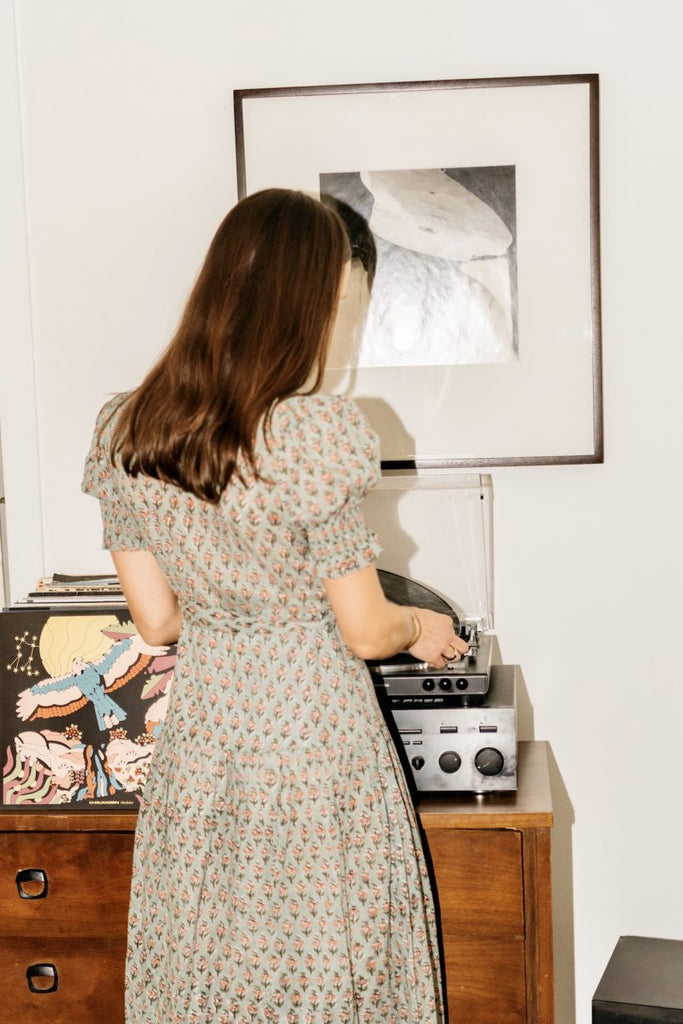Words by Kate Waitzkin, a writer and yoga/meditation teacher based in Austin
----------
Like many people, the word “ritual” didn’t become a consistent part of my personal vocabulary until much later in life. Similarly, my engagement with rituals as a guiding, daily practice didn’t begin to take shape until right around my 40th trip around the sun.
Yet, as I look back on my childhood, I see that the practice of ritual was always present in our home in one way or another. It rarely, if ever, involved a formal ceremony as is traditionally defined. Rather, ritual, as I’ve gradually grown to understand it, was an unspoken way of living. It’s a way of seeing, engaging with, and welcoming the world. In other words, it wasn’t saved just for the precious or seemingly monumental life moments. It was a chosen perspective expressed and woven into the fabric of even our most ordinary days.

I'm reminded of this when I reflect on the way my dad, a photographer, moved fluidly around his darkroom as he brought his images to life. Each step had a purpose and was taken with an undercurrent of joy and appreciation. His deep love and respect of the process was made clear by the way he danced through the space with a thoughtful tempo. I saw it in the way he handled the film and developing tools with tender care. And perhaps it was most evident in the palpable thrill and certainty that filled the room as his images emerged on the photographic paper.
How else did the perspective of rituals show up in my everyday life? It was my mom’s enchanting way of pulling threads of beauty out of the simplest of things and building experiences around them. Her dedicated choice to create seemingly sacred experiences out of the ordinary. She created a celebration of things that held meaning for her or for our family. Nothing fancy, but always full of beauty and intention.

Physically, rituals revealed themselves in the tiny altars and sacred spaces created and placed around our home. You could find them in various nooks, on dresser tops, and tucked-away corners. Some unchanging, others always evolving. They each served as daily reminders representing inspiration, personal significance, celebration, nature, or beauty.
With meals, the focus was always on the process of preparation and serving. There were sequential steps interwoven with spontaneity, filling the room with joy, conversation, music, and the celebration of aroma.

Daily Rituals Are an Intentional Practice
This approach to living wasn’t implicit in the way we talked about our days. Yet my parents, each in their own ways, offered insight into the value and importance of creating thoughtful experiences around people and things that held meaning for me. And this, I’ve come to understand, is a practice in ritual. Be it placing a tiny scrap of paper holding an inspiring word in the kitchen window and consciously taking it in each time I pass by, pausing for an extra breath as I kiss my partner goodbye for the day, or sitting outside with my toes in the grass and my face in the sun as I eat my mid-day meal. Choosing to see and create these experiences as an intentional practice of ritual, marks the moment and, I believe, makes it sacred by way of practice and consistency.
“The simplest things are also the most extraordinary things and only the wise can see them.” - Paulo Coelho

How to Build Daily Rituals Into Your Life
I find three ingredients important and helpful for building ritual into daily life: presence, perspective, and choice. Presence asks us to slow down and to open the eyes of our senses. In this greater awareness, we can begin to notice and acknowledge what holds meaning for us. Perspective invites us to see through a new lens. What if we saw all of life as a sacred ceremony? What if we trained our eyes to see the opportunity for ritual at any given moment? This reminds us that ritual is not just about doing, but is also a way of seeing. Finally, choice simply means to choose to mark the moment and create an experience as you feel inspired. Give yourself permission to allow ritual to be both consistent and spontaneous.
For most of us, the idea of adding even one more thing to your day feels overwhelming. Instead, begin by giving yourself five minutes to simply write down the things in your day that you already do consistently. This can look like waking up, brushing your teeth, pouring a cup (or three) of coffee or tea, preparing a meal, greetings and salutations with your loved ones, sitting down to your computer, etc. Next, choose one or two of these consistent daily practices and consider how you might layer and build a ritual onto a practice that is already there.

Examples of daily rituals to inspire your own
-
Celebrate the Day. As you open your eyes in the morning, place a hand over your heart and say to yourself, “Thank you for this day, thank you for this breath."
-
Transitions. Moments of transition in your days are an opportune time to bring in ritual. Notice the periods of natural transition and use these tiny windows of space to create an elevating, nourishing experience. One minute of deep breathing, a mindset check-in, drink a glass of water and practice gratitude for the nourishment, acknowledge a loved one, move your body (mid-day dance anyone?), apply an essential oil, set an intention for what comes next, etc.
-
Gratitude. As you brush your teeth, layer in a quiet gratitude practice. In silence, reflect on two or three things you feel grateful for.
-
Intentional Silence. Give yourself permission to practice intentional quiet as you prepare your cup of coffee, tea, or warm lemon water first thing in the morning. Invite your movements to be slow and mindful. Bring a meditative lens to each step of the process so that it becomes a moving meditation. Before you take your first sip, hold the cup between both hands and enjoy the warmth and aroma.
-
Early Riser. Even five minutes of time alone in the morning before the house wakes and your day “begins” can make a difference in how you feel and show up throughout your day. Try setting your alarm five or ten minutes earlier than you’re used to and settle into your favorite chair or dedicated meditation cushion. Sit quietly, observing your breath or listen to a guided meditation. Spend the final moments putting pen to paper.

-
Journey of Your Meal. As you prepare or sit down to your first meal of the day, give yourself permission to take a few deep breaths and honor all of the hands that made this meal possible.
-
Sacred Spaces. Create a tiny sacred space or altar at your desk at the start of each work day. This can look like a sticky note with your day’s intention, a photograph that brings joy and ease to your mind and body, or an essential oil you can reach for when you need grounding or energy. I also love building an altar somewhere in my home that I pass by regularly as a consistent reminder to pause, breathe, and land in the moment.
-
Tuning In. Take a few minutes mid-day to acknowledge how you’re feeling, where you’ve placed your energy and focus in the day thus far. Consider where you feel called to place your attention next. Perhaps a few conscious breaths, placing a hand over your heart, or brief meditation to set your intention for the remainder of your day.

-
Claiming “Enough." For many of us, the line between work life and home life is continually blurred. My therapist reminded me once that at some point, we have to decide we’ve done enough. I’ve found that marking the closing of the (work) day with a ritual helps me lay down my work and transition into the next part of my day with greater presence and joy. A few ideas: At the close of your day, cleanse your workspace with burning sage, speak the words to yourself: “I’ve done enough," draw a bath, light a candle, shake off (literally) the work day, or take a short walk around the block. Anything that helps you feel a sense of clearing and clarity.
-
Highs and Lows. This is one of the rituals my husband and I have built with our three boys. Each night over dinner, we take turns sharing one high and one low from the day. We close with sharing one word to describe how we’re feeling. It often gets silly (usually when it’s the dog’s turn to share), but we’ve found it to be a meaningful way to connect and check in with one another.
-
Seal the Day. I find that creating a bedtime ritual helps me fall asleep faster and stay asleep with more ease and consistency. I’m a big fan of essential oils, so my bedtime ritual revolves around a few favorites. I love on my feet (self-massage) with vetiver and a yarrow pom serum. I'll also roll magnolia or serenity restful blend on my pulse points just before turning out the lights. As you lay your head on the pillow, consider acknowledging the abundance in your life. Take your time with this and be specific. This often ushers me straight into a deep rest.
As you consider your own routines and possibilities for ritual, remember the sky is the limit and there are no rules! What might be possible if you reframe ritual as anything that brings more presence to your days and attunes you to your higher self. Remember: It' s yours to define, create, and to practice.
*editor's note: If you're interested in deepening your own rituals, join me for Kate's forthcoming The Ritual Practice, an online series kicking off next month. You can sign up for The Ritual Practice here.









